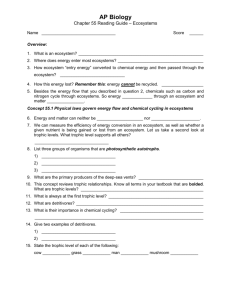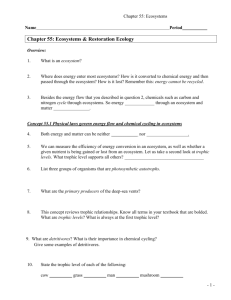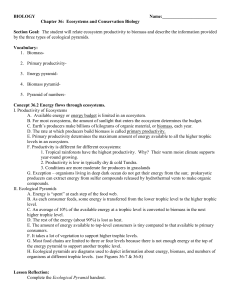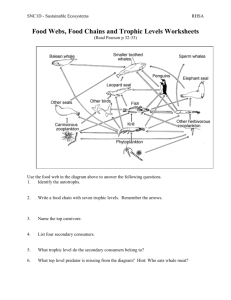Ch. 55 Ecosystems and Reading Guide
advertisement
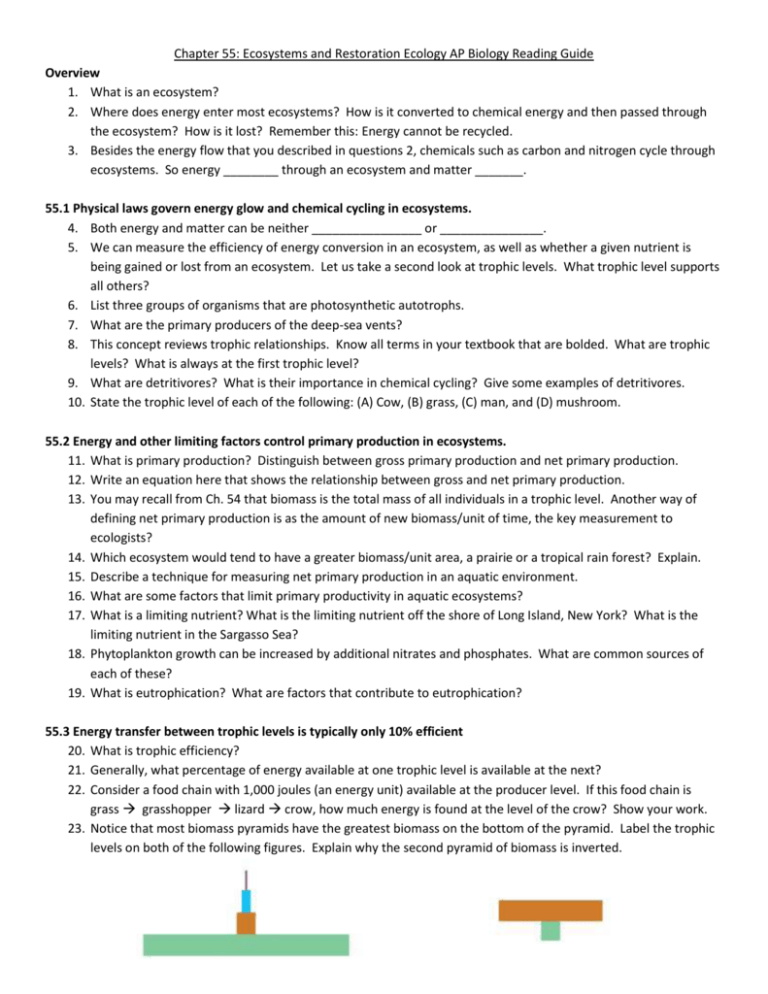
Chapter 55: Ecosystems and Restoration Ecology AP Biology Reading Guide Overview 1. What is an ecosystem? 2. Where does energy enter most ecosystems? How is it converted to chemical energy and then passed through the ecosystem? How is it lost? Remember this: Energy cannot be recycled. 3. Besides the energy flow that you described in questions 2, chemicals such as carbon and nitrogen cycle through ecosystems. So energy ________ through an ecosystem and matter _______. 55.1 Physical laws govern energy glow and chemical cycling in ecosystems. 4. Both energy and matter can be neither ________________ or _______________. 5. We can measure the efficiency of energy conversion in an ecosystem, as well as whether a given nutrient is being gained or lost from an ecosystem. Let us take a second look at trophic levels. What trophic level supports all others? 6. List three groups of organisms that are photosynthetic autotrophs. 7. What are the primary producers of the deep-sea vents? 8. This concept reviews trophic relationships. Know all terms in your textbook that are bolded. What are trophic levels? What is always at the first trophic level? 9. What are detritivores? What is their importance in chemical cycling? Give some examples of detritivores. 10. State the trophic level of each of the following: (A) Cow, (B) grass, (C) man, and (D) mushroom. 55.2 Energy and other limiting factors control primary production in ecosystems. 11. What is primary production? Distinguish between gross primary production and net primary production. 12. Write an equation here that shows the relationship between gross and net primary production. 13. You may recall from Ch. 54 that biomass is the total mass of all individuals in a trophic level. Another way of defining net primary production is as the amount of new biomass/unit of time, the key measurement to ecologists? 14. Which ecosystem would tend to have a greater biomass/unit area, a prairie or a tropical rain forest? Explain. 15. Describe a technique for measuring net primary production in an aquatic environment. 16. What are some factors that limit primary productivity in aquatic ecosystems? 17. What is a limiting nutrient? What is the limiting nutrient off the shore of Long Island, New York? What is the limiting nutrient in the Sargasso Sea? 18. Phytoplankton growth can be increased by additional nitrates and phosphates. What are common sources of each of these? 19. What is eutrophication? What are factors that contribute to eutrophication? 55.3 Energy transfer between trophic levels is typically only 10% efficient 20. What is trophic efficiency? 21. Generally, what percentage of energy available at one trophic level is available at the next? 22. Consider a food chain with 1,000 joules (an energy unit) available at the producer level. If this food chain is grass grasshopper lizard crow, how much energy is found at the level of the crow? Show your work. 23. Notice that most biomass pyramids have the greatest biomass on the bottom of the pyramid. Label the trophic levels on both of the following figures. Explain why the second pyramid of biomass is inverted. 24. Why do people who have limited diets in overpopulated parts of the world eat low on the food chain? 55.4 Biological and geochemical processes cycle nutrients and water in ecosystems. Use the pictures from Figure 55.14 to answer the questions the follow. 25. Describe the water cycle. Specify the roles of evaporation, transpiration, and rainfall in the water cycle. 26. Describe the carbon cycle. Explain how carbon enters the living system and how it leaves, indicate the role of microorganisms in the cycle, and identify the reservoir for carbon. Write the equation for photosynthesis and cellular respiration. 27. Describe the nitrogen cycle. Indicate the role of microorganisms in nitrogen fixation, nitrification, and denitrification. 28. Review the Case Study: Nutrient Cycling in the Hubbard Brook Experimental Forest. What effect has deforestation been shown to have on chemical cycling? 55.5 Restoration ecologists help return degraded ecosystems to a more natural state. 29. What is the goal of restoration ecology? 30. Restoration ecology uses two key strategies. Explain how each strategy works: (A) bioremediation and (B) biological augmentation.




